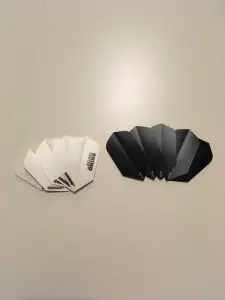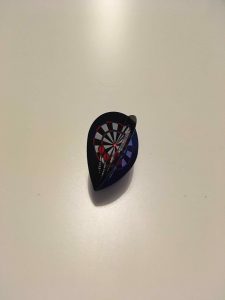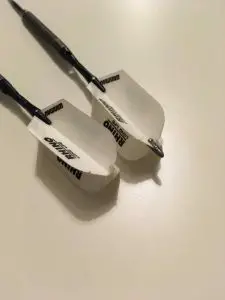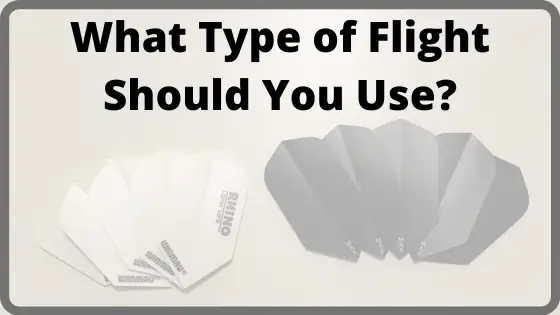Whilst there are thousands of darts flight designs to choose from there are only a handful of shapes and textures that you need to consider when getting a set.
If you are just starting out and have a basic set of darts that you received with the board or have a starter set then you are likely going to have a standard shape flight.
For now this is the best option to start practicing with and learning the game, once you get a hang for your throwing technique however then it will be time to test out different flights in order to find which one most compliments your throwing technique and darts set.
Why Do Darts Need Flights
You’d think that a dart is designed to fly accurately through the air (which it is) based on the streamlined design of the point and barrel, however the flights are what actually help to stabilize the dart in the air in the same way that wings on an aeroplane help keep it stable in the air.
For a flight to do this they are designed to be symmetrical and therefore all four sides need to be fanned out in an even distribution at a 90 degree angle. If two sides are flat against each other instead of being fanned out then the dart will wobble through the air significantly losing accuracy.
Darts stems are already designed to hold the flights in a spread and fanned out position however it is always worth checking or adjusting every few games just to get into the habit. Soon after you will develop the habit of fanning them out subconsciously and automatically.
What Are the Most Common Types of Flights
There are mostly two types of flights used by professional players and amateurs, these are standard and slim flights.
Standards flights are larger and less aerodynamic than the slim version which makes them sound like a bad choice. Standard flights are however the recommended choice for a beginner and also a seasoned player trying out a new set of darts.

With standard flights there is more drag through the air, this means they take longer to reach the board but travel better in a lob/arch and angles can be varied much easier. As many beginners don’t have a combination of power and accuracy that is needed with the slim flights then a standard is the ideal one to try out first.
Standard flights also help distribute weight better throughout the dart and prevent them from being too top heavy, meaning the dart will travel to the board with the point slightly angled upward (an ideal angle for a dart to hit the board is with the point slightly downward angled at less than a 10 degree angle). If you’re an experienced player this won’t be an issue as you can stack your darts but you do need a high level of accuracy and consistency in every throw for this to be effective.
A slim flight as the name suggests is smaller and slimmer than a standard flight and is ideal for players that either generate a lot of power in their throw or use a smaller/lighter dart usually under 19g. As these flights are more aerodynamic and have less drag through the air when thrown the dart will hit the board at an ideal flat angle.

As mentioned above however if the dart is too top heavy and it hits the board with an upward angle then you will struggle for consistency of throw unless you are capable of stacking (stacking your darts means landing one on top of another and as doubles and trebles are designed lengthways you will be cutting down your odds of heavy scoring).
What About the Texture of the Flights
There are two types of texture that most flights are made out of, smooth and dimplex.
As with the flight shape the texture will affect how the dart travels through the air. A smooth flight will have less drag and will contribute to a flatter dart angle, dimplex flights, similar to a standard flight will have more drag and is therefore more suited to a heavier dart or a lobbed throwing technique.
What Flights Do You Need for Your Darts
The flight you need will depend on a combination of your throwing technique and the weight, shape and length of your dart. The only real way to find which is best for the individual is to consider the following tips:
- The angle your dart hits the board should be as close to flat as possible, therefore a heavier dart with a long shaft and steel tips will be better suited to a standard flight. A light dart with a shorter shaft and soft tips will be better suited to a slim flight
- Your current level of ability will be a major factor, when learning to throw and getting a feel for different angles a standard flight is much more forgiving as it will travel slower through the air. Learning to angle shots from different situations will quickly bring up your game
- Your preference. This is a big one and darts for the most part can be a game of confidence, if you are nervous or not comfortable with your set of darts then this will have a negative impact on your performance. Therefore you can take the above advice on board when it comes to selecting a preferred set of flights but your final decision should be based on the flight that you feel most comfortable with.
To expand on that final point the only real way to see what flight is best suited to you is trial and error through practice and testing. It would be unwise to constantly make changes to your set up in game situations but certainly in practice you are afforded time to try out additional options and see what works best for your game.
Flights are so inexpensive that you can purchase one of each kind (you can even get bulk accessory sets that have an assortment) and practice with them for an equal amount of time to get a feel and see what you are most comfortable with.
Other Types of Flights
A kite shaped flight is designed to be slimmer the closer it is to the darts stem allowing for a better grouping of your darts (the wider the flight the more chance of a dart ricocheting off of it).

A pear shaped flight allows for maximum lift over a smaller surface area, this is useful for lighter darts and those that want to be able to vary the angle of their shot and allow for lobbed shots.
A lantern shaped flight is designed to be as aerodynamic as a slim flight however it is designed to keep the dart flat with minimal lift.
Protecting Your Flights

This is often an afterthought for most people, especially beginners. If you’re not yet at a level where you can accurately group your darts and your throws tend to be a bit scattered then you wouldn’t have even thought about this.
Once you become a bit more advanced however and start to group your darts more, then you will appreciate the need to protect your flights.
The number one reason for protecting your flights at this point is for longevity. Flights are in no way expensive but once you hit a flight and damage it then you will affect the aerodynamics of that flight. A split or damaged flight will lose accuracy and precision in the air and will therefore need changing to keep consistency of your throw.
The other reason and this is definitely for a more advanced player that competes at a league level or higher is to reduce bounce outs. When it comes to protecting flights you’ll use what is known as a flight protector, a point shaped aluminium accessory that goes on top of your flight.
When your dart point hits a flight without a protector on you are more likely to experience bounce outs, a flight protector is designed in such a way that if the point of another dart makes contact then it will slide off it and still stay on course for contact with the board.
Small changes like this are what can help improve your game by minimizing mistakes and helping to keep your 3 dart average up.

